Curule seat
A curule seat is a design of chair noted for its uses in Ancient Rome and Europe through to the 20th century. Its status in early Rome as a symbol of political or military power carried over to other civilizations, as it was also utilized in this regard by kings in Europe, Napoleon, and others.
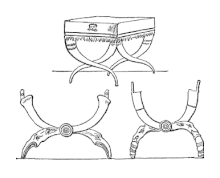
History
Ancient Rome
In the Roman Republic, and Empire, the curule chair (sella curulis, supposedly from currus, "chariot") was the seat upon which magistrates holding imperium were entitled to sit. This includes dictators, magistri equitum, consuls, praetors, curule aediles, and the promagistrates, temporary or de facto holders of such offices. Additionally, the censors and the Flamen of Jupiter (Flamen Dialis) were also allowed to sit on a curule seat,[2] though these positions did not hold imperium. Livy writes that the three flamines maiores or high priests of the Archaic Triad of major gods were each granted the honor of the curule chair.[3]
According to Livy the curule seat, like the Roman toga, originated in Etruria,[4] and it has been used on surviving Etruscan monuments to identify magistrates.[5] However, much earlier stools supported on a cross-frame are known from the New Kingdom of Egypt. One of the earliest recorded examples of the curule chair proper was in 494 BC when the honour of a curule chair in the circus maximus was awarded to the Roman dictator Manius Valerius Maximus as a result of his victory over the Sabines.[6] According to Cassius Dio, early in 44 BC a senate decree granted Julius Caesar the curule seat everywhere except in the theatre, where his gilded chair and jeweled crown were carried in, putting him on a par with the gods.[7] As a form of throne, the sella might be given as an honor to foreign kings recognized formally as allies by the Roman people or senate.[8] The curule chair is also used on Roman medals as well as funerary monuments to express a curule magistracy; when traversed by a hasta, it is the symbol of Juno.
In Rome, the curule chair was traditionally made of or veneered with ivory, with curved legs forming a wide X; it had no back, and low arms. Although often of luxurious construction, this chair was meant to be uncomfortable to sit on for long periods of time, the double symbolism being that the official was expected to carry out his public function in an efficient and timely manner, and that his office, being an office of the republic, was temporary, not perennial. The chair could be folded, and thus was easily transportable; this accords with its original function for magisterial and promagisterial commanders in the field. It developed a hieratic significance, expressed in fictive curule seats on funerary monuments, a symbol of power which was never entirely lost in post-Roman European tradition.[9] 6th-century consular ivory diptychs of Orestes and of Constantinus each depict the consul seated on an elaborate curule seat with crossed animal legs.[10]
Other uses
Along the Silk Road the folding seat of the Eastern Roman Empire[11] made its way to China, where in various forms including the hu chuang— the "barbarian bed"— it "transformed the dress, architecture and lifestyle of the Chinese"[12] In Han China the folding chair made its first literary mark in the 2nd century AD, used out-of-doors in a military rather than domestic setting, and from the way it was addressed in a poem by Yu Jianwu, written about 552
By the name handed down you are from a foreign region
coming into [China] and being used in the capital
With legs leaning your frame adjusts by itselfWith limbs slanting your body levels by itself...[13]
it is clear the cross-framed folding seat was intended.
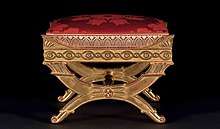
In Gaul the Merovingian successors to Roman power employed the curule seat as an emblem of their right to dispense justice, and their Capetian successors retained the iconic seat: the "Throne of Dagobert", of cast bronze retaining traces of its former gilding, is conserved in the Bibliothèque nationale de France. The "throne of Dagobert" is first mentioned in the 12th century, already as a treasured relic, by Abbot Suger, who claims in his Administratione, "We also restored the noble throne of the glorious King Dagobert, on which, as tradition relates, the Frankish kings sat to receive the homage of their nobles after they had assumed power. We did so in recognition of its exalted function and because of the value of the work itself." Abbot Suger added bronze upper members with foliated scrolls and a back-piece. The "Throne of Dagobert" was coarsely repaired and used for the coronation of Napoleon.[14]
In the 15th century, a characteristic folding-chair of both Italy and Spain was made of numerous shaped cross-framed elements, joined to wooden members that rested on the floor and further made rigid with a wooden back. 19th-century dealers and collectors termed these "Dante Chairs" or "Savonarola Chairs", with disregard to the centuries intervening between the two figures. Examples of curule seats were redrawn from a 15th-century manuscript of the Roman de Renaude de Montauban and published in Henry Shaw's Specimens of Ancient Furniture (1836).[15]
The 15th or early 16th-century curule seat that survives at York Minster, originally entirely covered with textiles, has rear members extended upwards to form a back, between which a rich textile was stretched. The cross-framed armchair, no longer actually a folding chair, continued to have regal connotations. James I of England was portrayed with such a chair, its framing entirely covered with a richly patterned silk damask textile, with decorative nailing, in Paul van Somer's portrait. Similar early 17th-century cross-framed seats survive at Knole, perquisites from a royal event.[16]
The photo of actor Edwin Booth as Hamlet poses him in a regal cross-framed chair, considered suitably medieval in 1870.
The form found its way into stylish but non-royal decoration in the archaeological second phase of neoclassicism in the early 19th century. An unusually early example of this revived form is provided by the large sets of richly carved and gilded pliants (folding stools) forming part of long sets with matching tabourets delivered in 1786 to the royal châteaux of Compiègne and Fontainebleau.[17] With their Imperial Roman connotations, the backless curule seats found their way into furnishings for Napoleon, who moved some of the former royal pliants into his state bedchamber at Fontainebleau. Further examples were ordered, in the newest Empire taste: Jacob-Desmalter's seats with members in the form of carved and gilded sheathed sabres were delivered to Saint-Cloud about 1805.[18] Cross-framed drawing-room chairs are illustrated in Thomas Sheraton's last production, The Cabinet-Maker, Upholsterer and General Artist's Encyclopaedia (1806), and in Thomas Hope's Household Furniture (1807).
With the decline of archaeological neoclassicism, the curule chair disappeared; it is not found among Biedermeier and other Late Classical furnishing schemes.
Gallery
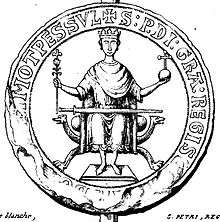 Engraving of a sealing of Peter II, ca 1196—1213[19]
Engraving of a sealing of Peter II, ca 1196—1213[19] John II of France, seated on the "Throne of Dagobert" (unusually adorned with dogs' heads), founds the Order of the Star in 1351; manuscript illumination (Bibliothèque nationale)
John II of France, seated on the "Throne of Dagobert" (unusually adorned with dogs' heads), founds the Order of the Star in 1351; manuscript illumination (Bibliothèque nationale)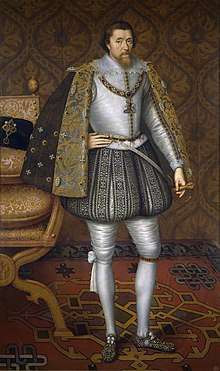 James I of England (ruling 1603–13) with a royal cross-framed armchair and standing on an Oriental carpet, by Paul van Somer
James I of England (ruling 1603–13) with a royal cross-framed armchair and standing on an Oriental carpet, by Paul van Somer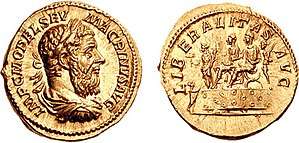
 The American actor Edwin Booth as Hamlet, seated in a curule chair, c. 1870
The American actor Edwin Booth as Hamlet, seated in a curule chair, c. 1870
See also
- Barcelona chair
- Faldstool
- Glastonbury chair
- List of chairs
- Magistratus Curulis
- Porter's chair
- Seat of honor
- X-chair
References
| Wikimedia Commons has media related to Curule seats. |
-

- Livius (Livy), Titus (1974). Robert Maxwell Ogilvy (ed.). Ab Urbe Condita: Volume I: Book I (in Latin) (2nd ed.). USA: Oxford University Press. p. 416. ISBN 978-0-19-814661-2.
- Ab urbe condita 1:20
- Livy, Ab urbe condita, I.8: Me haud paenitet illis auctoribus assentiri, quibus et apparitores hoc genus ab Etruscis finitimis, unde sella curulis, unde toga praetexta sumpta est...
- Thomas Schäfer, Imperii insignia: Sella Curulis und Fasces. Zur Repräsentation römischer Magistrate, (Mainz) 1989, fully discusses the representations of curule seats and their evolving significance.
- Livy, Ab urbe condita, 2:31
- Peter Michael Swan, The Augustan Succession: An historical Commentary on Cassius Dio's Roman History Books 55-56 (9 B.C.-A.D. 14), "Commentary on Book 56", (Oxford 2004) p. 298, noting T. Schäfer 1989, pp 114-22.
- Stefan Weinstock, "The Image and the Chair of Germanicus," Journal of Roman Studies 47 (1957), p. 148 and note 38.
- Schäfer 1989.
- Discussed and illustrated in Nancy Netzer, "Redating the Consular Ivory of Orestes" The Burlington Magazine 125 No. 962 (May 1983): 265-271) p. 267, figs. 11-13.
- Further east, the cultures of Persia employed the cushioned divan instead (Frances Wood, The Silk Road: two thousand years in the heart of Asia, 2002:85-87).
- Wood 2002:85.
- Quoted in Wood 2002:86.
- Sir W. Martin Conway, The Treasures of Saint Denis, 1915
- Some are illustrated in John Gloag, A Short Dictionary of Furniture, rev. ed. 1969: s.v. "X-chairs".
- The contemporary term "cross-framed" came to be employed in the later 17th century to describe chairs with rigid horizontal cross-framed x-stretchers, possibly causing confusion for a modern reader; see Adam Bowett, "The English 'Cross-Frame' Chair, 1694-1715" The Burlington Magazine 142 No. 1167 (June 2000:344-352).
- Pierre Verlet, French Royal Furniture p. 75f; F.J.B. Watson, The Wrightsman Collection (Metropolitan Museum of Art) 1966:vol. I, cat. no. 51ab, pp76-78.
- One at the Victoria and Albert Museum is illustrated in Serge Grandjean, Empire Furniture, (London: Faber and Faber) 1966:fig. 7. Grandjean also illustrates a gilded curule seat from the former Grand Galerie, Malmaison, ca 1804 (fig. 5b); a painted one from Fontainebleau (fig. 31), and a walnut curule seat in Empire style, from Romagna (fig. 6).
- From Louis Blancard, Iconographie des sceaux et bulles, 1860.